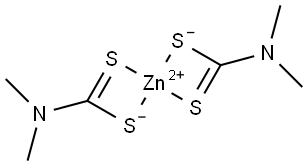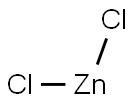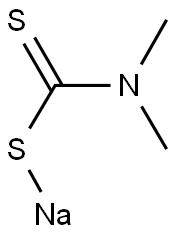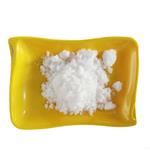Chemical Properties
White and odorless when pure. Almost insoluble inwater; soluble in acetone,
carbon disulfide, chloroform, dilute alkalies,
and concentrated hydrochloric acid.
Uses
Ziram is a protective fungicide applied to foliage to control diseases
on pome fruit, stone fruit, nuts, vines, vegetables and ornamentals.
It is used to control scab in apples and pears and Monilia, Alternaria,
Septoria, peach leaf curl, shot hole, rusts, black rot and anthracnose. It is
also used as a wildlife repellent, smeared as a paste onto tree trunks or
sprayed onto ornamentals, dormant fruit trees and other crops.
Uses
Rubber vulcanization accelerator; agricultural fungicide.
Uses
Zinc Dimethyldithiocarbamate is a member of a class of dithiocarbamates, and has been used in agriculture as a fungicide and in the rubber industry as a vulcanization accelerator.
Definition
ChEBI: A dithiocarbamate salt that is the zinc salt of dimethyldithiocarbamic acid. It is a broad-spectrum fungicide and bird and animal repellent that is also used to accelerate the vulcanisation of rubber.
Air & Water Reactions
Thio and dithiocarbamates slowly decompose in aqueous solution to form carbon disulfide and methylamine or other amines. Such decompositions are accelerated by acids. Insoluble in water.
Reactivity Profile
Zinc bis dimethyldithiocarbamate is a dithiocarbamate. Flammable gases are generated by the combination of thiocarbamates and dithiocarbamates with aldehydes, nitrides, and hydrides. Thiocarbamates and dithiocarbamates are incompatible with acids, peroxides, and acid halides. Zinc bis dimethyldithiocarbamate is corrosive to iron and copper. Zinc bis dimethyldithiocarbamate is incompatible with strong oxidizing agents and acids. Zinc bis dimethyldithiocarbamate is also incompatible with mercury.
Hazard
Strong irritant to eyes and mucous membranes.
Fire Hazard
Zinc bis dimethyldithiocarbamate is combustible. Zinc bis dimethyldithiocarbamate may form explosive dust-air mixtures.
Flammability and Explosibility
Not classified
reaction suitability
reagent type: catalyst
core: zinc
Agricultural Uses
Fungicide, Microbiocide, Animal repellant: Ziram is an agricultural fungicide registered to
control fungal diseases on a wide range of crops including stone fruits, pome fruits, nut crops, vegetables and
commercially grown ornamentals, and as a soil and seed
treatment. In addition, it is formulated as a bird and rabbit
repellent for outdoor foliar applications to ornamentals.
Registered for use in EU countries
. Registered for use
in the U.S.
Trade name
AAPROTECT®; AAVOLEX®; AAZIRA®;
ACCELERATOR®-L; ACCELERATOR® MZ® Powder;
ACETO ZDED®; ACETO ZDMD®; ALCOBAM ZM®;
ANCANZATE ME®; CARBAZINC®; CIRAM®;
CORONA COROZATE®; COROZATE®; CUMAN®;
CUMAN L®; CYMATE®; DRUPINA® 90; EPTAC-1®;
FUCLASIN®; FUCLASIN® ULTRA; FUKLASIN®;
FUNGOSTOP®; HERMAT ZDM®; HEXAZIR®;
KARBAM WHITE®; KYPZIN®; METHASAN®;
METHAZATE®; MEXENE®; MEZENE®; MILBAM®;
MILBAN®; MOLURAME®; MYCRONIL®;
OCTOCURE ZDM-50®; ORCHARD® BRAND ZIRAM;
PERKACIT ZDMC®; POMARSOL® Z FORTE;
PRODARAM®; PROKIL® Ziram; RHODIACID®;
SOXINAL®-PZ; SOXINOL®-PZ; TRICARBAMIX Z®;
TSIMAT®; TSIRAM® (Russian); ULTRA ZINC DMC®;
VANCIDE® MZ-96; VANCIDE® 51Z Dispersion (with
Zinc 2-mercaptobenzothiazolate); VANCIDE® 51Z
Dispersion (with Ziram); ZERLATE®; ZINCMATE®;
ZIMATE®; ZIMATE®; METHYL®; ZIRAMVIS®;
ZIRASAN®; ZIRBERK®; ZIREX 90®; ZIRIDE®;
ZIRTHANE®; ZITOX®
Contact allergens
Ziram is a rubber vulcanization accelerator of the
dithiocarbamate group. Sensitization was reported in
several patients. Ziram is also used as a fungicide and
can cause contact dermatitis in agricultural workers.
Safety Profile
Poison by ingestion,intraperitoneal, and intravenous routes. Moderately toxicby inhalation. Questionable carcinogen with experimentalcarcinogenic and tumorigenic data. An experimentalteratogen. Other experimental reproductive effects.Human mutation d
Metabolic pathway
Ziram is one of the metal containing dithiocarbamates which generates
dimethyldithiocarbamic acid by being cleaved in acidic conditions and
in biological media. The resulting acid is conjugated with glucose and
alanine in plants and with glucuronic acid in mammals. Dimethyldithiocarbamic
acid is further degraded to dimethylamine and CS2. An extensive
review of the properties of dithiocarbamate pesticides was published
by the World Health Organisation (WHO, 1988) from which much of the
following information is taken.
Purification Methods
Crystallise this herbicide several times from hot toluene or from hot CHCl3 by addition of EtOH. [Beilstein 4 III 149, 4 IV 234.]
Degradation
Ziram is decomposed in acidic media and by UV irradiation (PM). Ziram
is stable in alkaline media but unstable in acidic conditions, decomposing
to dimethylamine and carbon disulfide.









